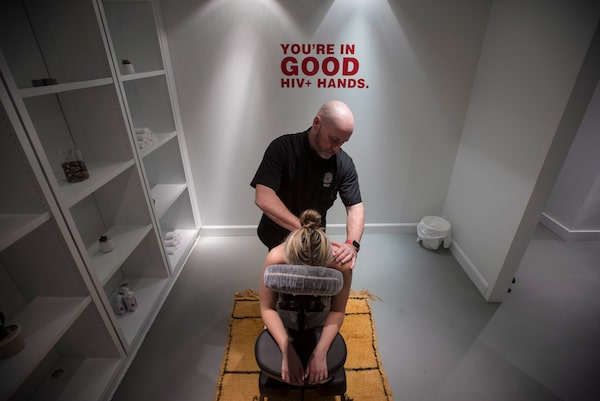
Randy Davis, who is HIV-positive, demonstrates a head, neck and shoulder massage on Jackie Kleinberg at the Healing House, the world's first pop-up HIV+ spa in Toronto on in 2018.Tijana Martin/The Canadian Press
Sean Rourke is a scientist at the MAP Centre for Urban Health Solutions, St. Michael’s Hospital and Canadian Foundation for AIDS Research (CANFAR) adviser. Trevor Stratton is Indigenous leadership policy manager at CAAN – Communities, Alliances & Networks. Notisha Massaquoi is assistant professor and director of the University of Toronto’s Black Health Equity Lab. Bill Flanagan is president and vice-chancellor of the University of Alberta. The latter three are CANFAR board members.
Today in Montreal, Canada’s political leaders are participating the AIDS 2022 conference, bringing the world together to accelerate the fight to end HIV and AIDS globally. Unless their words can be translated into political will and action, we will be no further ahead in ending HIV in Canada.
The number of new HIV cases in Canada has been on the rise over the past five years, and in 2020 (our most recent national estimates of HIV surveillance), four people were infected with HIV every day. However, this is likely an underestimate – we expect to see a higher rate of new HIV infections in 2021 and 2022 because COVID-19 significantly restricted access to HIV testing and treatment.
It is shameful that we are still not getting testing and treatment to those who need it most.
We are among the worst of the G7 countries in making significant progress in achieving the UNAIDS 95-95-95 targets of diagnosing 95 per cent of HIV cases, getting 95 per cent of those people on life-saving treatment, and getting the virus levels of 95 per cent of that group to “undetectable” levels so they can live healthy lives. Most concerning are recent numbers from 2020 that show women are doing worse than men overall in access to testing and treatment – and Indigenous Peoples (First Nations, Métis and Inuit), racialized communities, including African, Caribbean and Black people, and people who use substances and inject drugs, are doing the worst overall.
Having HIV is no longer a death sentence, but people who are infected need to be tested and have access to treatment that will suppress the virus. Unfortunately, one out of 10 people living with HIV is undiagnosed (they have HIV but don’t know it). That’s more than 6,500 people in Canada who are not able to benefit from antiviral treatment. If they don’t get access to testing and are not properly diagnosed, they will get very sick at some point and develop AIDS. And those undiagnosed and without their virus suppressed may also unknowingly infect others.
We have all of the tools and knowledge we need to correct these shortcomings.
In November 2020, we worked to get the first HIV self-test approved in Canada, and then research programs were developed and implemented to provide low barrier access to home testing using technology platforms. But our governments have yet to take up these successful initiatives and scale them sufficiently to reach all of those who are undiagnosed across Canada.
Further concrete actions are required. First, we need the federal government and each provincial government to commit to reaching the 95-95-95 targets by 2025 with a focus on key populations most impacted by HIV. This is important because it defines a clear goal of what is necessary to turn the tide with the HIV epidemic.
Second, we need an implementation task force, with both federal and provincial representation, that has the mandate and authority to bring the health, public health and community-based sectors together to implement an action plan. Essential to making this work is a multi-stakeholder leadership group with community representation and people with lived experience. This group should also look at best practices with reaching targets in jurisdictions around the world, including initiatives such as the global Fast-Track Cities.
And third, in order to meet a timeline of 2025, there will need to be clear and measurable targets that can be monitored and reported on at regular intervals to ensure progress and accountability.
Many other countries have already achieved what we have outlined here – it is inexcusable that we have not done the same in Canada. So today, we will stand up, rally with our colleagues and implore our political leaders locally, provincially and federally to commit the necessary leadership and political will to ensure everyone has the access to the testing and treatment they need, no matter where in Canada they live.
Knowing what we know, it’s time to stand up and make sure we end HIV in Canada.
Keep your Opinions sharp and informed. Get the Opinion newsletter. Sign up today.